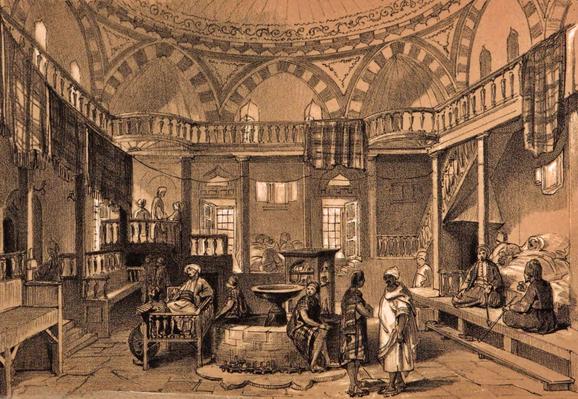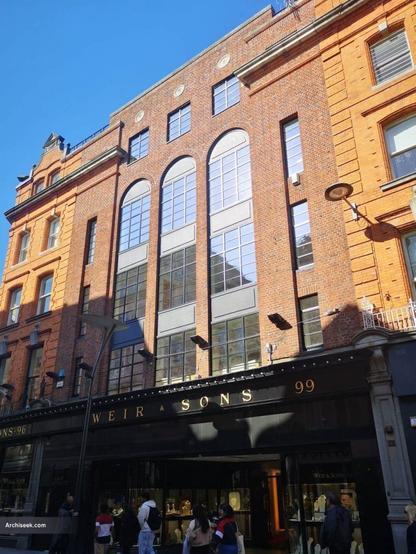✏️ Vestiary and Resting Room of the Çinili Hammam (Turkish Bath), 1844 #Hamam #TurkishBath #TurkishBaths
#TurkishBaths
1934 – Maskora Turkish Baths, Nos. 97-99 Grafton Street, Dublin
Architect: George L. O'Connor
Nos. 97-99 were demolished in the early 1930s to be replaced with the Maskora Turkish Baths by George L. O'Connor - a facade with Art Deco features and graceful tall round-headed windows. Beautifully inserted int
https://www.archiseek.com/1934-maskora-turkish-baths-nos-97-99-grafton-street-dublin/
#ArchitectureOfDublinCity #1934 #GeorgeLOConnor18701947 #GraftonStreetDublin #TurkishBaths
We're the oldest members-run swimming club in Europe. Our beloved #Victorian building in the Woodlands area of #Glasgow opened in 1871. We love #swimming, #architecture.#history,#TurkishBaths, #art, #music and #community. Find us at: https://arlingtonbaths.co.uk
New Yorker: Soak and the City https://www.newyorker.com/culture/on-and-off-the-avenue/soak-and-the-city #NewYorker #Culture/OnandOfftheAvenue #Culture/PhotoBooth #Turkishbaths #NewYorkCity #Wellness #Bathing #Health
The historically important Turkish Baths in Carlisle originally opened in 1909 and Carlisle City Council voted to close the doors in October 2022.
#Carlisle #TurkishBaths
https://northwestbylines.co.uk/lifestyle/culture-language-and-religion/progress-in-saving-carlisles-victorian-and-turkish-baths/
#OnThisDay—5 Feb 1894—#Southampton Corporation opened #TurkishBaths to complete their Western Shore Road Baths. Money was borrowed for "vapour baths" as it was thought—wrongly—that local authorities were precluded from building Turkish baths (which had not existed when the Baths & Wash-Houses Acts were passed). The higher women's charge was soon lowered.
Costing £1,100, the baths comprised a dressing room, 3 hot rooms, shampooing room, plunge & cooling-room. Closed mid-1930s.
#histodons #bathing
#OnThisDay—5 Feb 1895—City of London Alderman Treloar opened #TurkishBaths built for Nevill's on a site by Bishopsgate Churchyard which had housed baths of various kinds since c.1817—Much illustrated article at http://www.victorianturkishbath.org/_6DIRECTORY/AtoZEstab/London/NewBroad/NewBroadEng.htm
Designed by architect G Harold Elphick, who also designed some of the special tiles made by Craven Dunnill. Built in "Oriental" style with the underground baths entered through an upper kiosk.
Baths closed 1954 but Listed building remains.
#OnThisDay—2 Feb 1878—the formal opening of the Victoria Baths Club at Butterbiggins Road took place on completion of its #TurkishBaths—reported as being 'the only specimen we have in #Glasgow of the Moorish style of architecture'. The design competition was won by local architect T L Watson. A unique study compared the stoves at the Victoria & Arlington Baths Clubs.(https://books.google.co.uk/books?id=2fAUAAAAIAAJ&pg=PA493&hl=ar&source=gbs_toc_r&cad=4#v=onepage&q&f=false). Closed 'for the duration of the war' in 1942, the club never re-opened.
#histodons #bathing #heating
#OnThisDay—2 Feb 1861—Charles Bartholomew, a farmhand's son & Secretary of David Urquhart's #Bristol Foreign Affairs Committee, opened his College Green #TurkishBaths, replacing a small experimental one at Mill La, Bedminster. When he died in 1889, he owned a chain of 8 Turkish baths spread from Manchester to Eastbourne. Bristol's was open till at least mid-1940s. Except for the façade, the building—originally the Great Western Hotel built for #Brunel—was demolished in 1982.
#histodons #bathing
@nigelpstanley Sambourne was a regular user of #Turkishbaths, which he often visited, as did several other members of the Punch Table. #histodons
#OnThisDay—27 Jan 1879—the original Kent Street Baths in #Birmingham were augmented by #TurkishBaths. These were built at a cost of £1,255.10.0 by converting the underused washhouses. The plunge pool, with 14 cubicles, adjoining hot rooms at 145 & 195 deg.F, a shampooing room with marble slab & various showers, was below the cooling-room with its 8 rest cubicles.
In 1930 the baths were demolished & new ones on the same site, also incl Turkish baths, opened 3 years later.
#histodons #bathing
#OnThisDay—25 Jan 1897—the #Doncaster Oriental & #TurkishBaths Co Ltd opened baths at their Oriental Buildings, Station Rd (the building with the cupola on the right in first image).
The building also contained 6 shops & 17 offices.
The cooling room has divans for 9, hot rooms at 145, 170, & 240 degr.F, shampooing room, plunge & showers.
The Glyn Hotel, in the advert, became the Central Hotel. In 1930, a Miss Roberts ran the baths as Robert's Turkish Baths until they closed c.1932.
#histodons
#OnThisDay—20 January 1973—the Burns Leisure Centre was opened in the High Street, Stanley (Co. Durham) by the local council. It included one of the last Victorian-style #TurkishBaths to be built. However, they survived only 24 years, closing on 4 September 1997. Little is known about them (or, alas, remembered by me!). Anyone else remember using them? #histodons
#OnThisDay—17 January 1911—the Chester Turkish Baths Co Ltd opened #TurkishBaths for Gentlemen in Bridge Street, & announced that those for Ladies would open early in March. In 1889 the local Council had intended that their new public baths should include Turkish baths, but this didn't happen. Local architect Wm T Lockwood designed them. They comprised a 10 cubicle cooling-room, 3 hot rms, shampooing rm, showers, & a Russian vapour bath. Closing date unknown. No image found—Any known? #histodons
@aleebrahim #histodons That little pebble, just on the right of the 19th century layer, is my specialism, Victorian #TurkishBaths, and I'm probably exaggerating its size.
#OnThisDay—1 January 1891—Mr Francis James (of the Albany Road #TurkishBaths in Wolverhampton) decided to start his New Year by opening another one in Priory Street, #Coventry. He did so by converting an unfinished Weslyan chapel into a well equipped facility with 1st & 2nd Class cooling-rooms, 3 hot rooms ranging from 130 to 240 degrees. Additionally, there were Russian and electric baths. The baths were demolished c.1920. More information in an article at http://www.victorianturkishbath.org/_6DIRECTORY/AtoZEstab/England/Coventry/CoventryEng.htm
#histodons
#OnThisDay—29 December 1874—The #Otago Turkish Bath Co Ltd opened the 1st #TurkishBaths to be built in #NewZealand. Originally managed by one of the Burton family which ran the long-established Turkish baths in London's Euston Rd. There were 2 hot rooms, a cooling-room, a shampooing room, a steam bath, sitz baths and a large (36 ft x 24 ft) cold water swimming pool. In 1890 the baths were sold to William Asher, and he leased them to Herman Döring who ran them till they closed in 1908. #histodons
My avatar is taken from an advertisement in 'White's Directory of Hampshire, 1878' for the Southampton #TurkishBaths in Regent Street. They were opened by John Rose in 1870 and were later bought by the Southampton Turkish Baths Co Ltd, who re-sold them in 1880 to a new company with the same name. They closed in 1886. #histodons
The 3 pix on my profile header (l to r): The #TurkishBaths opened, 1858, by the Leeds Foreign Affairs Committee, shown at unknown later date (Leeds Library and Information Services Leodis ID 20031017_79638309);
Poster advertising the Leeds Oriental Baths in 1858,
as actually built (Leeds Library and Information Services);
William Potter's 2nd Turkish baths, Clifford Street, Manchester, unearthed 2013 (courtesy Oxford Archaeology). Extra image: Potter's baths as advertised in 1859. #histodons

